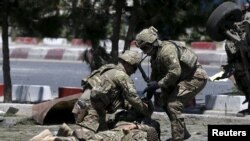NATO special operations forces, whom world leaders say have not been in a combat role since the end of 2014, are still out in the field with Afghan forces almost nightly, a U.S. general in Afghanistan said Thursday.
“On average, we [NATO] probably have somebody out every night or every other night at some place in the country,” U.S. Brig. General Charles Cleveland told reporters Thursday at the Pentagon. Cleveland, a NATO spokesman, was speaking remotely from Kabul.
About 10 percent of all Afghan missions are advised by NATO forces, including the recent high-profile mission to stop an attack on the American University of Afghanistan (AUAF) and the deadly operation near Lashkah Gah in volatile Helmand Province where U.S. Staff Sgt. Matthew Thompson was killed by a bomb earlier this week.
“We’ll put NATO forces out with that Afghan organization as they move to an objective, [but] we don’t put NATO forces on the objective,” Cleveland explained. He said NATO forces are instructed to “stop at the last safe location” as the Afghans move forward to conduct the operation.
For example, during the AUAF attack Wednesday in Kabul, the general said the Afghan Ministry of Interior conducted the mission on campus while NATO counterparts advised. While he could not be certain whether any NATO forces set foot on the campus ground, he said none of the NATO advisers were in an “area where there was risk.”
The frequency of the NATO operational tempo along in the height of the Afghan fighting season, however, creates a dangerous situation for NATO forces assisting their Afghan allies.
In the recent mission near Lashkar Gah, U.S. forces were helping Afghan allies clear the area of Taliban so conventional forces could move in. In this case, U.S. Staff Sgt. Thompson encountered an explosive device while traveling on foot to help advise the Afghan clearing mission.
Another 10 percent of Afghan missions are “enabled” by NATO forces, Cleveland said, meaning NATO will help them plan and provide ISR while the Afghans go outside the wire to conduct a mission.
The remaining 80 percent of the Afghan missions are conducted without NATO forces.








